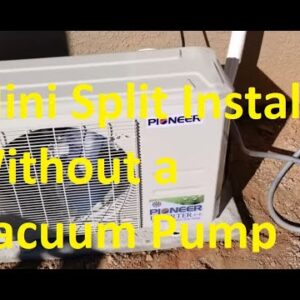Exploring Mini Split Installation Without a Vacuum Pump
Many individuals frequently inquire about the viability of installing a mini split system without the aid of a vacuum pump or the necessity of applying a vacuum to the system. The answer is affirmative; alternatives exist for those who prefer not to utilize a vacuum pump. In this discussion, we’ll delve into these options, elucidating how you can install a mini split efficiently without relying on traditional vacuuming methods.
The Importance of Vacuuming a Mini Split System
To comprehend the rationale behind using a vacuum pump during the installation of a mini split, it’s crucial to grasp the purpose it serves. The primary function of pulling a vacuum on a mini split is to eliminate any undesired elements that may infiltrate the system. When you set up a mini split, you’ll typically have an indoor unit, an outdoor condenser, and a line set interconnecting the two components.
Prior to releasing the refrigerant contained within the outdoor unit, it’s imperative that no contaminants, such as moisture or oxygen, reside within the system. These impurities can wreak havoc, leading to potential damage. Minute water particles in the air can convert to corrosive acids, which can severely affect the operational longevity of the unit. Thus, it is essential to eradicate these substances to ensure the system operates effectively for years to come.
Optimally Utilizing a Vacuum Pump
The most recommended approach for installing a mini split is employing a vacuum pump, as endorsed by the majority of mini split manufacturers. By doing so, you ensure that all foreign elements are removed, allowing the system to function at its peak capacity. However, if using a vacuum pump is not feasible for you, several alternative methods can still yield satisfactory results.
Alternative Options for Installing Without a Vacuum Pump
1. Quickie Evac Line Set Flushing Kit
One alternative method involves the utilization of the Quickie Evac Line Set Flushing Kit, available from Pioneer, a reputable manufacturer of mini splits. Numerous practitioners opt for this technique, which can be an effective way to clear the line set of unwanted particles.
To implement this approach, follow these steps: first, fasten all the connections of your line set, leaving one connection loose on the high-pressure side. Next, you’ll attach the canister from the flushing kit to the Schrader valve on the system. Opening the canister allows the propellant to enter the system, which will then traverse through the line set and exit through the high-pressure side. This action is designed to expel any air and minute debris residing in the system.
After allowing the flushing to continue for a brief duration, typically around five to ten seconds (as specified in the kit’s instructions), you can secure the final connection on the high-pressure side. Since the canister remains open and is actively pressurizing the system, you can subsequently test for leaks using soapy water.
This Quickie Evac Flushing Kit is not a novel concept; it has been in utilized for many years, initially employing R11 refrigerant but now utilizing R152a. While I personally harbor reservations about this method, many users report favorable outcomes. I will include links to this product below for your convenience, as ample reviews indicate a significant level of satisfaction among users.
2. Quick Connect Mini Split Kits
The second alternative worth exploring is the Quick Connect Mini Split Kit, a highly commendable choice. These systems are pre-sealed, featuring a closure at the end that remains intact until the units are fastened together, ensuring that the system is essentially in a vacuum state right from the outset.
The principal advantage of employing Quick Connect systems is the efficacy they offer. When installed correctly, these units provide a solution that rivals the traditional vacuuming method. However, a notable drawback is that they are typically priced higher than standard mini split units. Homeowners who are budget-conscious may need to weigh this factor carefully.
Among the more prominent Quick Connect mini split systems is the Mr. Cool line, which has garnered significant popularity among DIY enthusiasts. My personal experience installing various Mr. Cool units has been overwhelmingly positive, as each setup continues to function effectively. Nevertheless, it’s essential to acknowledge that these kits may lean more towards the pricier side compared to other brands such as Pioneer or Senville.
If you are inclined to explore this option, I will provide links below for additional information on Quick Connect Mini Split Kits.
Conclusion: Making an Informed Choice
In conclusion, while the ideal method for installing a mini split involves the use of a vacuum pump, various alternatives can suffice if a vacuum pump is not an option. The Quickie Evac Line Set Flushing Kit and Quick Connect Mini Split Kits are both viable methods that have been successfully employed by many individuals.
If you have any experiences to share or questions to ask regarding mini split installations, feel free to leave a comment below. Your insights are valuable. Should you find this information helpful, please consider liking and subscribing for more content. Have a splendid day!

